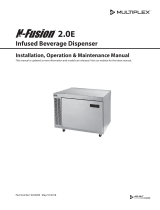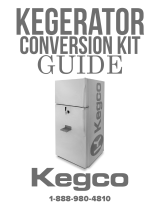
Summit Appliance Division · Felix Storch, Inc. · www.summitappliance.com · 718-893-3900 · info@summitappliance.com
INSTALLATION INSTRUCTIONS FOR COLD BREW COFFEE TAP KITS
Flat Iced Coffee Kits: KitCF KitCFTWIN
Nitro-Infused Coffee Kits: KitNCF KitNCFTWIN
Combination Flat/Nitro Kit: KitCMTWIN
Parts & Equipment
(not included)
Installation
(Note: These instructions apply primarily to Summit SBC635M models, but most details should correspond to other kegerators as well.)
1. Put draft tower directly over the hole on the top of the coffee dispenser’s upper
surface. Fix the tower assembly with screws directly to the upper surface of the
dispenser. (See Fig. 1.)
2. Using a wrench, tighten the hex nut port on the regulator valve to the N
2
gas
outlet on the N
2
gas cylinder. (See Fig. 2.)
Fig. 2
Fig. 1

Summit Appliance Division · Felix Storch, Inc. · www.summitappliance.com · 718-893-3900 · info@summitappliance.com
3. Place the N
2
gas cylinder into the bracket on the rear wall of the kegerator’s
inside cabinet and fix the N
2
cylinder with the bolt. (See Fig. 3.; note: some
units do not include a bracket)
4. Carefully place the keg inside the kegerator. Attach the coffee tube from the
tower to the “out” post of the of the Cornelius keg by pushing the ball lock
down over the “out” post until it snaps in place. (See Fig 4.)
5. Attach the N
2
tube to the “in” post of the Cornelius keg by pushing the ball lock
down over the “in” post unit it snaps on.
6. Set the desired pressure on the regulator valve. If serving flat iced coffee, open the regulator valve
and set the pressure between 4-8 psi. If serving nitro-infused coffee, set the pressure between 30-45
psi.
7. Install the tap handle(s) and coffee tap(s). Screw the tap handle clockwise into the coffee tap to make
a firm connection, then connect the tap to the coffee tower components and tighten with a wrench.
NOTE: If serving nitro-infused coffee, agitate the keg before serving.
8. Install the upper cover guardrail (provided with your kegerator) and drip tray.
Notes:
• These taps are designed for dispensing coffee and should not be used for milk or any other
substance.
• When replacing the coffee keg, first turn the safety switch on the N
2
regulator valve and remove
the ball locks to take out the keg.
• When replacing the N
2
gas cylinder, remember to turn off the main switch of the N
2
tank and
the safety switch on the N
2
regulator valve. Afterwards, use a wrench to loosen the hexagonal
nut port connecting the N
2
regulator valve with the N
2
tank. Then, using a wrench, remove the
fixed bolt of the N
2
tank.
• During the installation process, be sure that all parts are connected tightly and that there are no
gas leaks.
• High-pressured compressed gas in the N
2
tank can be dangerous if not handled properly. For
optimum safety, make a note of the D.O.T. testing date on the cylinder neck before installation.
If it is more than 5 years old, do not use.
• Keep the gas cylinder away from heat sources. Unused cylinders should be placed upright in a
cool, ventilated place, preferably at 70°F.
Fig. 3
Fig. 4
-
 1
1
-
 2
2
Summit SBC58BLBIADAIFNCFTWINLHD Operating instructions
- Type
- Operating instructions
- This manual is also suitable for
Ask a question and I''ll find the answer in the document
Finding information in a document is now easier with AI
Related papers
-
Summit SEH1530CADA Installation guide
-
Summit SBC635MCMTWIN User manual
-
Summit SMWEM210 Summit_Anti-Tip_Bracket
-
Summit REX2431B User manual
-
Summit TTM21027BRSW Anti Tip Bracket
-
Summit REX2431B Anti Tip Bracket
-
Summit TTM6107CSRT Summit Anti Tip Bracket
-
Summit WTM6107SWRT Summit Anti Tip Bracket
-
Summit SBC635MCMTWIN User manual
-
Summit KitNCF Brochure KitNCF
Other documents
-
Zephyr PRKRAIL-0124SS Presrv Kegerator Drink Guardrail User manual
-
 KitchenCare N2Fusion™ 2.0E Nitrogen Beverage System Owner Instruction Manual
KitchenCare N2Fusion™ 2.0E Nitrogen Beverage System Owner Instruction Manual
-
NewAir Kegerator AK-200 User manual
-
MULTIPLEX N2Mobile Owner Instruction Manual
-
U-Line UHDE215-SS03A Quick start guide
-
U-Line UHDE215-SS03A User guide
-
U-Line UHDE215-SS03A User guide
-
 Kegco STCK Kit Guide
Kegco STCK Kit Guide
-
MULTIPLEX N2Fusion Nitrogen Beverage Dispenser User manual
-
MULTIPLEX N2-Fusion ND21TS02 Owner Instruction Manual



